The Role of UAV Surveyors in Modern Surveying Techniques
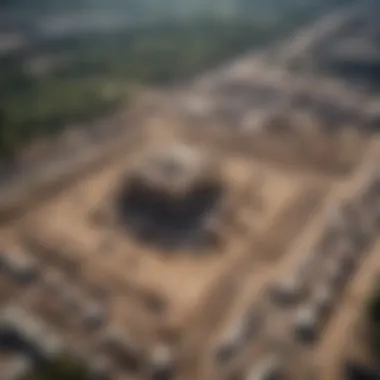
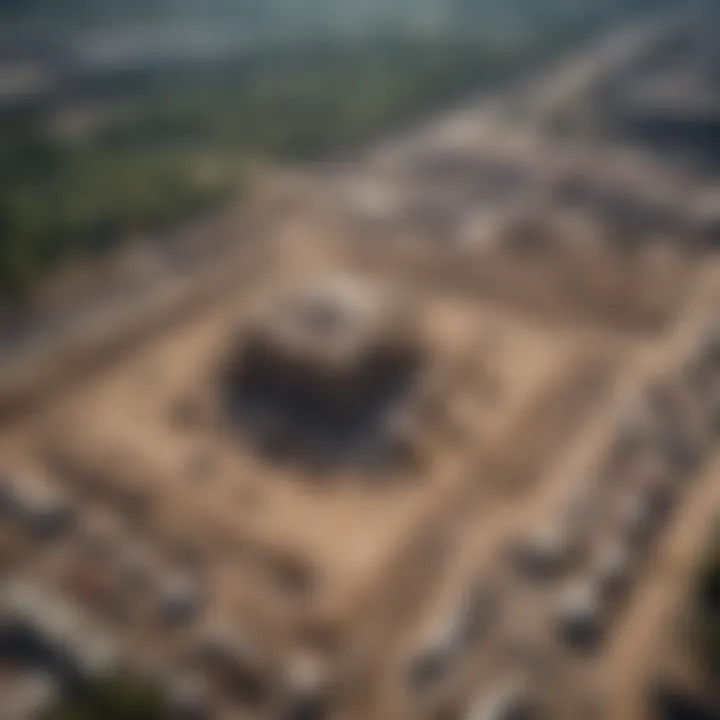
Intro
The integration of Unmanned Aerial Vehicles (UAVs), commonly known as drones, has significantly transformed traditional surveying practices. As UAV surveyors operate these advanced tools, they incorporate cutting-edge technology that enhances precision and efficiency in measuring and mapping tasks. This section sets the stage for a deeper understanding of how UAV surveying has evolved and the vast implications it has for various sectors.
In the following sections, we will explore the key findings regarding the role of UAVs in surveying, the methodologies employed in this innovative approach, and the potential future of this evolving field.
Preamble to UAV Surveying
UAV surveying has emerged as a significant component in the landscape of modern surveying techniques. This practice utilizes unmanned aerial vehicles, also known as drones, to capture high-resolution data for various applications. The integration of UAVs into surveying methodologies presents numerous advantages compared to traditional methods.
Drones can cover vast areas in a fraction of the time, providing data that is both accurate and accessible. This efficiency translates into lower costs and faster project completion while minimizing human error. The use of UAVs also opens up new possibilities in areas that might be challenging to access, thus expanding the scope of surveying.
Furthermore, UAV surveying plays a key role in enhancing data collection methods. The technology is constantly evolving, with advancements in sensors and imaging techniques contributing to improved data quality. As sectors such as construction, agriculture, and environmental studies increasingly rely on accurate mapping and modeling, the relevance of UAV surveyors becomes even more apparent.
Definition of UAV Surveying
UAV surveying refers to the practice of using unmanned aerial vehicles to gather geographical data. These drones are equipped with specialized technologies such as cameras, LiDAR systems, and various sensors to capture imagery, topographic information, and more. The collected data helps surveyors create accurate maps and models for analysis. UAV surveyors utilize flight planning software to direct the drone's path, ensuring comprehensive coverage of the designated area.
The resulting data is processed using photogrammetry or other methods to produce detailed outputs, like 3D models and orthomosaics. As the technology matures, UAV surveying continues to transform how professionals approach mapping tasks.
History and Evolution
The use of UAVs in surveying is relatively recent but has evolved rapidly over the last two decades. Originally, drones were primarily military tools. Over time, their application expanded into the civilian sector, driven largely by advances in technology. In the early 2000s, the advent of affordable UAV platforms paved the way for wider use in industries such as agriculture and construction.
As UAV technology progressed, so did the sensors and data collection techniques. Early drones typically presented limitations in range and payload capacity. However, modern UAVs can carry advanced sensors that significantly enhance their data-gathering capabilities.
Today, UAV surveying has transitioned into a specialized field, with professionals focusing on aerial mapping to provide insights for projects in various sectors. This evolution underscores the importance of UAV surveyors as key players in modern surveying techniques, adapting traditional methods to meet the demands of a fast-paced world.
Technological Advancements in UAV
The advancement of technology in Unmanned Aerial Vehicles (UAV) has drastically transformed surveying techniques. UAVs have become essential tools for professionals in the surveying industry. These advancements not only increase the efficiency of surveys but also enhance the accuracy of data collection. As UAV technology evolves, surveyors can utilize more sophisticated tools and methods, which contribute to better decision-making processes in various fields.
Types of UAVs Used in Surveying
Different types of UAVs serve specific roles in surveying applications. These vehicles can be classified based on their design and function:
- Fixed-Wing UAVs: These are more efficient for large areas due to their ability to cover more distance and maintain speed. Fixed-wing designs are advantageous in topographic and environmental surveys.
- Multi-Rotor UAVs: These UAVs are driven by multiple rotors and are generally used for their maneuverability in small areas. They are ideal for applications requiring high-resolution imagery, such as detailed inspections.
- Hybrid UAVs: These combine the features of fixed-wing and multi-rotor UAVs. They can take off and land vertically but also have the endurance of fixed-wing models.
Choosing the right type of UAV is crucial for the success of any surveying project.
Sensor Technology in UAVs
The sensor technology integrated into UAVs plays a vital role in their effectiveness. Advanced sensors enhance the capabilities of UAVs, allowing for comprehensive data collection. Below are key types of sensor technologies used in UAVs:
LiDAR Technology
LiDAR stands for Light Detection and Ranging. This technology uses laser light to measure distances, creating detailed 3D maps. Its key characteristic is the ability to penetrate vegetation, which allows for ground mapping. This adds significant value in forestry and environmental studies. LiDAR is popular because it delivers precise and fast data collection, making it highly beneficial in various surveying situations. However, it can be costly and requires expertise to process the data effectively.
Multispectral Imaging
Multispectral imaging captures data at different wavelengths of light. It enables surveyors to monitor vegetation health and soil conditions effectively. The key characteristic of this technology is its capacity to provide information beyond what the human eye can see. This makes it useful in agriculture and resource management. Its unique feature lies in its ability to analyze plant health through specific indices. Despite its advantages, multispectral imaging faces limitations in terms of data complexity and the need for specialized knowledge to interpret the results.
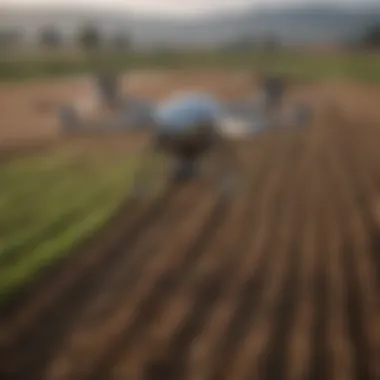
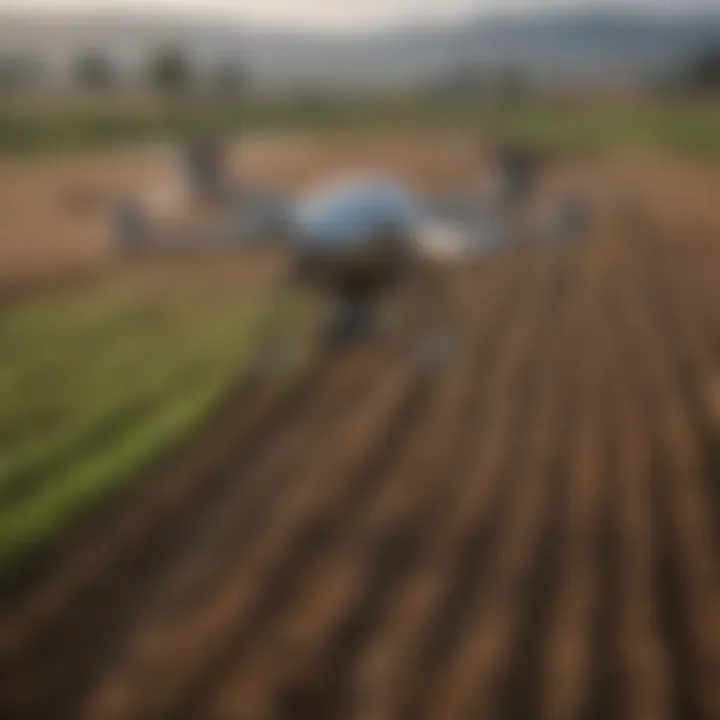
RGB Cameras
RGB cameras are the most common type used in UAVs. They function similarly to traditional cameras but with the ability to capture aerial images. The key feature of RGB cameras is their affordability and ease of use. This technology is beneficial for creating detailed photomaps and 3D models. The unique aspect is their capacity to deliver high-resolution images suitable for various applications. However, RGB cameras are limited in their capacity to capture data in specific light conditions compared to other sensors.
UAV technology is not only about flying but also about acquiring meaningful data that drives critical decision-making.
Understanding each sensor's role and capabilities is essential for selecting the appropriate technology based on the project requirements. These advancements in UAV surveying reflect a substantial shift in modern surveying techniques, emphasizing precision, efficiency, and the role of technology in the future of the industry.
UAV Surveying Methodology
UAV surveying methodology is critical in realizing the full potential of drones in modern surveying. This section explores how structured methodologies enhance the effectiveness and precision of UAV activities. Planning, data acquisition, and data processing are key components in ensuring a successful UAV survey. Each step must be thoughtfully executed, considering unique site requirements and survey objectives, to optimize resource utilization and extract actionable insights from collected data.
Planning a UAV Survey
The planning phase sets the foundation for a successful UAV survey. It starts with defining the objectives clearly. Are you mapping terrain, monitoring crop health, or assessing construction sites? Knowing the purpose guides subsequent decisions.
Next, it is essential to conduct a site assessment. Understanding the terrain features, vegetation types, and potential obstacles helps in choosing the appropriate flight paths and UAV models. In addition, regulatory compliance must be checked. Familiarity with local UAV regulations is vital. It can determine where and how you can operate, avoiding legal complications later.
A flight plan is then drafted, including altitude, speed, and camera settings. Simulation tools can be used to visualize the flight path. This validates the plan and ensures safety and efficiency. It's crucial for operators to keep in mind factors like battery life and airspace restrictions. A systematic approach prevents data loss and optimizes the survey process.
Data Acquisition Techniques
Data acquisition is the next step, which focuses on gathering accurate information. This phase is directly impacted by the planning stage. Proper equipment selection is crucial. Each UAV equipped with specific sensors can yield different data types. For instance, LiDAR sensors can capture detailed elevation data, while RGB cameras are suitable for basic aerial photography.
During the flight, operators must monitor real-time data feeds. This ensures that the UAV is functioning correctly and allows for immediate adjustments if needed. Field conditions can change rapidly, and adapting can prevent issues.
Furthermore, overlapping flight paths should be established to ensure complete coverage of the area. This redundancy helps in creating high-resolution images and enhances the reliability of later analyses. The acquired data must meet pre-defined quality standards, ensuring that it is sufficient for tasks like photogrammetry or vegetation analysis.
Data Processing and Analysis
Once data is collected, the next phase is processing and analysis. Raw data must be transformed into meaningful information. This involves using specialized software that stitches aerial imagery together or analyzes LiDAR data for topographical models.
Processing can be resource-intensive. It requires efficient algorithms to manage large datasets quickly. A common software used in this space includes Pix4D and Agisoft Metashape. These tools automate key tasks, allowing for quicker turnarounds and improved outputs.
After processing, validation of the results is necessary. This might involve cross-referencing with ground control points or other reliable datasets. Quality control is significant, as inaccuracies can affect decision-making in applications like construction planning or environmental assessments.
Ultimately, good data analysis should produce maps, models, or reports that are informative and actionable.
"Proper methodology in UAV surveying ensures data integrity and enhances overall project efficiency."
Applications of UAV Surveying
UAV surveying represents a significant shift in modern surveying practices. The hands of UAV surveyors embody the tools that provide greater efficiency, cost-effectiveness, and unprecedented accuracy across various applications. The uses of drones in sectors such as construction, agriculture, environment, and mining showcase the versatility and transformative power of UAV technology. This section explores these applications in detail, highlighting the specific elements, benefits, and considerations that come with each.
Construction and Infrastructure
In the construction industry, UAV surveying has become an invaluable asset. Drones allow for rapid collection of data via aerial imagery and topographic mapping. Surveyors can produce high-resolution images and 3D models in real time, ensuring accurate project planning.
Key benefits include:
- Time Efficiency: Utilizing drones reduces survey time significantly, allowing teams to focus on other crucial tasks.
- Safety: UAVs can easily survey dangerous areas, reducing the risk for human surveyors.
- Cost Reduction: Fewer labor hours and reduced equipment costs make UAVs a budget-friendly solution.


However, it is essential to consider challenges such as regulatory compliance and the need for skilled operators to analyze the data effectively.
Agricultural Monitoring
UAVs serve as a potent tool in agricultural monitoring. Farmers use drones equipped with specialized sensors to assess crop health and optimize resources. The ability to gather multispectral and thermal imaging data enables farmers to make informed decisions about irrigation, fertilization, and pest control.
Important aspects include:
- Precision Agriculture: Drones provide detailed insights that enhance yield and reduce waste.
- Crop Health Assessment: Regular drone surveys enable early detection of disease or nutrient deficiencies.
Farmers must also be aware of environmental considerations and data management challenges associated with UAV use.
Environmental Assessments
Environmental monitoring through UAVs plays a critical role in assessing impacts on ecosystems. Drones collect multispectral data for surveying lands affected by natural disasters, pollution, or climate change.
Benefits of UAVs in this field include:
- Detail and Coverage: Drones can cover large areas quickly and capture details invisible to the naked eye.
- Real-Time Data: Ongoing monitoring can help in timely environmental management.
However, UAV surveyors must adhere to regulations to protect sensitive ecological areas during data collection.
Mining and Resource Management
The mining industry has integrated UAVs as a means to enhance resource management. Drones provide crucial geological mapping, stockpile measurement, and exploration data. By using UAVs, mining companies can better predict resource availability while improving operational efficiency.
Key considerations involve:
- Increased Safety: Drones inspect areas such as unstable terrain without risking human lives.
- Data Accuracy: UAVs collect highly precise data that can aid in strategic planning and resource allocation.
Despite the advantages, mining operations must also consider the technical limitations, such as battery life and data processing requirements.
UAV surveyors are shaping the future of data collection across industries, addressing crucial challenges while offering innovative solutions.
Challenges and Limitations
Understanding the challenges and limitations of UAV surveying is critical. While UAVs bring numerous advantages, such as increased efficiency and safety, they also encounter specific hurdles that must be acknowledged. Each of these challenges affects the deployment and reliability of UAV technology in surveying tasks. It's important to consider these factors to enhance practices and properly apply UAV technology in various contexts.
Regulatory Considerations
The regulatory landscape for UAV operations is complex and varies widely across regions. Regulators such as the Federal Aviation Administration (FAA) in the United States play a pivotal role in defining operational guidelines. UAV surveyors must navigate through restrictions regarding altitude, no-fly zones, and necessary certifications. Failure to adhere to these regulations can lead to significant penalties and operational setbacks. Therefore, staying informed about local laws is crucial for UAV surveyors.
Surveying firms often invest time and effort in understanding the regulatory requirements. This helps in ensuring compliance and avoiding legal challenges. As the technology evolves, regulations are also being updated, which adds another layer of complexity for UAV surveyors.
"Adherence to UAV regulations is not just a legal requirement but also an ethical responsibility that ensures safety and reliability in surveying."
Technical Limitations
While UAVs are advancing quickly, they still face technical limitations. These include issues related to battery life, operational range, and the payload capacities of different models. Battery life is particularly critical as it directly affects how long a UAV can operate in the field, which impacts data collection tasks.
If a UAV runs out of power, the survey may need to be re-scheduled, leading to inefficiencies. Moreover, UAVs require a strong signal for effective communication. When working in remote locations, matching the UAV's range with available operational conditions can be challenging.
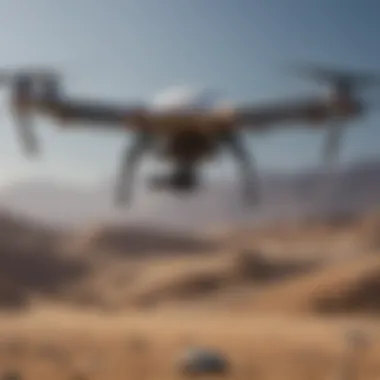
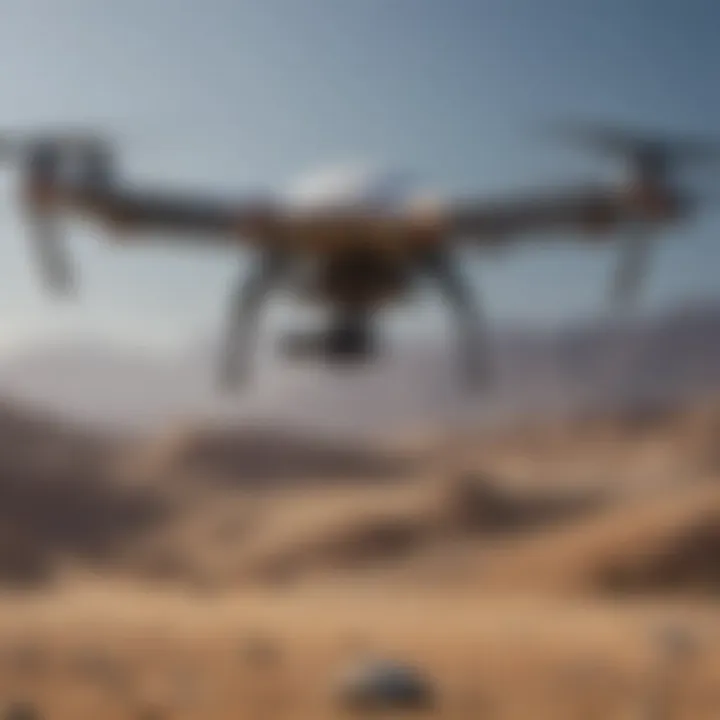
Additionally, the quality and type of sensors used can limit the effectiveness of data collection. For instance, while LiDAR offers accurate topographic data, it may not be suitable for every application. As technology progresses, these issues are beginning to see improvements, yet they remain important considerations for UAV surveyors.
Data Privacy Concerns
Data collection techniques used by UAV surveyors raise significant privacy issues. UAVs often capture extensive amounts of information, which can inadvertently infringe on personal privacy. This is something that surveyors should actively consider.
Concerns can arise regarding how the data is stored, who has access to it, and what is done with that information. To address these issues, it is crucial for UAV operators to implement strict data management protocols.
Public awareness of privacy rights is growing, and UAV surveyors must be proactive in ensuring compliance with privacy laws. Measures such as obtaining consent where necessary can mitigate risks associated with data collection. Additionally, using data anonymization techniques can enhance confidence in UAV practices and foster better community relations.
Future of UAV Surveying
The future of UAV surveying holds significant implications for a variety of sectors including construction, agriculture, and environmental management. With the ongoing expansion of drone technology, UAV surveyors are increasingly capable of collecting high-quality data efficiently. This progress leads to better decision-making processes that are based on accurate and timely information. Moreover, UAVs offer a cost-effective solution compared to traditional surveying methods, making this technology attractive for businesses looking to optimize their operations.
Emerging Trends and Innovations
An important trend is the increasing adoption of autonomous drones. These UAVs can complete surveying tasks with minimal human intervention, significantly enhancing productivity. Another emerging innovation is the integration of advanced sensors. With LiDAR and multispectral imaging technologies, drones can gather intricate detail from survey sites, revealing data that was previously difficult to obtain without significant time and resources.
Additionally, regulatory frameworks are also evolving. As governments and organizations establish clearer guidelines for UAV usage, this paves the way for wider acceptance and application of drone surveying in various fields.
Integration with Other Technologies
GIS and Remote Sensing
Geographic Information Systems (GIS) and remote sensing play a crucial role in enhancing the capacities of UAV surveyors. GIS allows for efficient mapping and analysis of spatial data. It enables surveyors to visualize terrain changes over time, assess land use, and generate accurate topographic maps. The synergistic relationship between GIS and UAV surveying is beneficial because it provides detailed geographical context.
The key characteristic of GIS is its ability to manage and manipulate geographical data easily. This makes it a popular choice among engineers, planners, and environmental scientists. One unique feature of GIS when integrated with UAVs is the capability to create comprehensive 3D models. These models reveal not just surface details but also subsurface information, aiding in more informed decision-making.
However, there are challenges. Data management can become complex when handling massive volumes generated from UAV surveys, necessitating robust data processing solutions.
Artificial Intelligence
Artificial Intelligence (AI) is also shaping the future of UAV surveying. AI algorithms can analyze data collected by UAVs, identifying patterns and anomalies that a human operator might miss. This ability enhances the quality of insights derived from survey data, making it an invaluable asset.
A remarkable characteristic of AI is its machine learning capabilities. Over time, AI systems can improve their analysis based on new data sets, providing increasingly precise recommendations. This dynamic aspect makes AI a desirable choice for UAV surveyors, who seek to leverage technology for improved outcomes.
The integration of AI introduces unique features as well. For instance, AI can automate the process of object detection in survey images, allowing surveyors to focus on strategic decision-making rather than data processing. Yet, reliance on AI also presents challenges, primarily concerning the quality of data. Poor input data can lead to misleading outputs, thus emphasizing the need for careful preliminary data validation.
"As UAV technology advances, the opportunities for precision surveying multiply, promising greater efficiency and accuracy across sectors."
In summary, the future of UAV surveying is marked by innovative trends and the integration of sophisticated technologies. The synergy of UAVs with GIS and AI enhances capabilities and expands applications across various fields. As these technologies continue to evolve, they will define the next generation of surveying, providing robust tools for data accuracy and efficiency.
The End
The importance of this conclusion lies in synthesizing the information presented and reflecting on the journey through UAV surveying. This article explores the role of UAV surveyors as key figures in modern surveying techniques, showcasing how their work integrates advanced technology with practical applications.
Summary of Key Points
- Definition and Importance: UAV surveying simplifies data collection; it is less intrusive and allows access to hard-to-reach areas.
- Technological Advancements: The evolution of UAVs, from basic drones to sophisticated multi-sensor platforms, showcases the rapid advancements in this field.
- Methodologies: Planning and executing a UAV survey requires specific methodologies that enhance accuracy and efficiency in data gathering.
- Applications: UAV surveying plays a vital role in various sectors, including construction, agriculture, and environmental assessments, providing rich data for better decision-making.
- Challenges: Despite the benefits, UAV surveying faces obstacles such as regulatory concerns and technical limitations that must be addressed.
- Future Trends: The integration of AI and other technologies suggests a promising future for UAV surveyors, enhancing their capabilities and the precision of data collected.
Final Thoughts on the Impact of UAV Surveyors
UAV surveyors are fundamentally changing the landscape of surveying. Their work not only offers precision and efficiency but also supports sustainable practices across various sectors. As technology continues to evolve, the role of UAV surveyors will expand further. They will increasingly integrate with industries, providing critical data that drives informed decision-making.
"In the intersection of technology and surveying, UAV surveyors stand at the forefront of innovation, pushing the boundaries of what is possible."
The continuous advancements in UAV technology and methodology promise to refine the way land and resources are assessed, paving the way for smarter and more efficient practices. The potential of UAV surveying seems limitless, offering benefits that resonate across disciplines. Students, researchers, and professionals alike must pay close attention to this evolving field, as it is likely to shape the future of surveying methods significantly.







